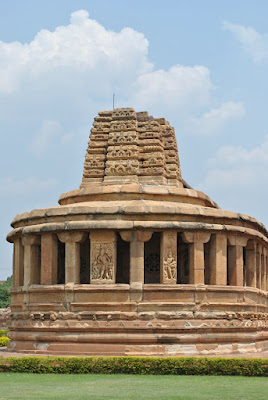My friends and I had travelled to North Karnataka seeking the cradle of temple architecture of India. Here's part two of my blog on our journey through the ages.
Badami:
Badami:
Badami was the second capital of the Chalukyas and was founded by Pulikesi-I in 540 AD. Badami is called so because of the colour of rocks is the same as the nut Badami (or Almond). The main temples have been hewn out of sand stone on the precipice of a hill. Cave style is the most difficult form of temple building because there is only one opportunity to get the sculptures right. No second chance to replace a broken statue with another one built elsewhere.
 |  | |
| Anantasana - Vishnu on a nagashesha | Shiva Thandava |
There are four cave temples, three Hindu and one Jain. The first cave is the oldest and has a stunning sculpture of Shiva with 18 arms in a dancing posture- the apocalyptic Shiva Thandava. The Ardhanarishwara (half-Shiva, half-Parvathi) and the Harihara (half-Vishnu, half-Shiva) are the other main sculptures in cave 1. Caves 2 and 3 are dedicated entirely to Vishnu. Cave 2 has a sculpture of Vishnu sitting on a lotus- The Anantasana, the image that is ubiquitous in every reference to Badami. Cave 4 has images of Digambara Jains, Tirthankaras and Mahavira and goes some way in showing the secular nature of the Chalukyan rulers.
 |
| Front view of the Badami caves |
These caves also served as shelter houses at lean times and you can also see carvings of board games like Pallanguli(Many-Holes) and HuliMane(Lion House) indicating the presence of young children. There are no palaces in Badami (unlike Hampi) to show that the rulers lived in splendour and research shows that the rulers resided in wooden houses while building these majestic caves temples for the Gods to reside in.
Pattadakal:
Pattadakal is situated on the banks of the Uttara Vahini River and is supposed to be the pinnacle of Chalukyan architecture. It was established in the later stages around 7-8th century AD. Pattadakal literally means rock of coronation in Kannada. It is also called as Shilapura or the place of sculptures. All the temples here are Shiva temples (unlike Badami and Aihole) and all of them face the East. There is also a Jain temple built later by the Rashtrakuta rulers.
 |
| Mallikarju |
 |
| View of all temples in Pattadakal |
Pattadakal is a UNESCO world heritage site and has ten major temples, a co-existence of Dravidian, Aryan and hybrid style of temple building. The textured carvings on the pillars are full of stories of Ramayana, Mahabharata and the DashaAvatars of Vishnu. We could also find a rich trove of stories from Panchatantra carved on the pillars. In 1565 AD, the Bahamani Sultan ransacked the place, but let the temple structures remain intact. I imagine that perhaps the conqueror recognized that such a fusion of art, architecture and skill is rare and deserves its place in history.
P.S: The link to my Picasa web album with pictures from the trip: http://goo.gl/photos


